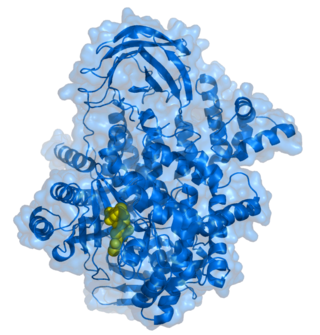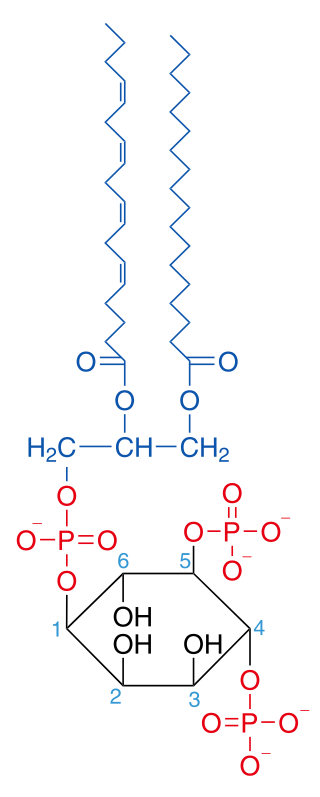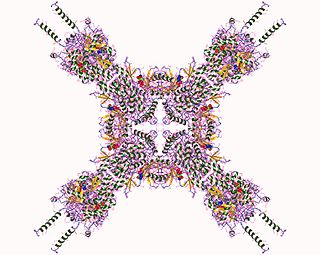
In biochemistry, a kinase is an enzyme that catalyzes the transfer of phosphate groups from high-energy, phosphate-donating molecules to specific substrates. This process is known as phosphorylation, where the high-energy ATP molecule donates a phosphate group to the substrate molecule. This transesterification produces a phosphorylated substrate and ADP. Conversely, it is referred to as dephosphorylation when the phosphorylated substrate donates a phosphate group and ADP gains a phosphate group. These two processes, phosphorylation and dephosphorylation, occur four times during glycolysis.

Phosphatidylinositol consists of a family of lipids made of a phosphate group, two fatty acid chains, and one inositol molecule. They represent a class of the phosphatidylglycerides. Typically phosphatidylinositols form a minor component on the cytosolic side of eukaryotic cell membranes. The phosphate group gives the molecules a negative charge at physiological pH.

Phosphoinositide phospholipase C is a family of eukaryotic intracellular enzymes that play an important role in signal transduction processes. These enzymes belong to a larger superfamily of Phospholipase C. Other families of phospholipase C enzymes have been identified in bacteria and trypanosomes. Phospholipases C are phosphodiesterases.

Phosphatidylinositol (3,4,5)-trisphosphate (PtdIns(3,4,5)P3), abbreviated PIP3, is the product of the class I phosphoinositide 3-kinases' (PI 3-kinases) phosphorylation of phosphatidylinositol (4,5)-bisphosphate (PIP2). It is a phospholipid that resides on the plasma membrane.

Phosphoinositide 3-kinases (PI3Ks), also called phosphatidylinositol 3-kinases, are a family of enzymes involved in cellular functions such as cell growth, proliferation, differentiation, motility, survival and intracellular trafficking, which in turn are involved in cancer.

Phosphatidylinositol 4,5-bisphosphate or PtdIns(4,5)P2, also known simply as PIP2 or PI(4,5)P2, is a minor phospholipid component of cell membranes. PtdIns(4,5)P2 is enriched at the plasma membrane where it is a substrate for a number of important signaling proteins. PIP2 also forms lipid clusters that sort proteins.
The enzyme phosphatidylinositol-3,4,5-trisphosphate 3-phosphatase (EC 3.1.3.67) catalyzes the chemical reaction
The enzyme phosphoinositide 5-phosphatase (EC 3.1.3.36) catalyzes the reaction
In enzymology, a 1-phosphatidylinositol-3-phosphate 5-kinase is an enzyme that catalyzes the chemical reaction

In enzymology, a 1-phosphatidylinositol 4-kinase is an enzyme that catalyzes the chemical reaction
In enzymology, 1-phosphatidylinositol-4-phosphate 5-kinase is an enzyme that catalyzes the chemical reaction
In enzymology, a 1-phosphatidylinositol-5-phosphate 4-kinase is an enzyme that catalyzes the chemical reaction
In enzymology, an inositol-tetrakisphosphate 1-kinase is an enzyme that catalyzes the chemical reaction
In enzymology, an inositol-tetrakisphosphate 5-kinase is an enzyme that catalyzes the chemical reaction
In enzymology, a phosphatidylinositol-4-phosphate 3-kinase is an enzyme that catalyzes the chemical reaction
Bisphosphate may refer to:
Inositol-polyphosphate multikinase is an enzyme with systematic name ATP:1D-myo-inositol-1,4,5-trisphosphate 6-phosphotransferase. This enzyme catalyses the following chemical reaction
inositol-1,3,4-trisphosphate 5/6-kinase is an enzyme with systematic name ATP:1D-myo-inositol 1,3,4-trisphosphate 5-phosphotransferase. This enzyme catalyses the following chemical reaction
Phosphatidylinositol-4,5-bisphosphate 4-phosphatase (EC 3.1.3.78, phosphatidylinositol-4,5-bisphosphate 4-phosphatase I, phosphatidylinositol-4,5-bisphosphate 4-phosphatase II, type I PtdIns-4,5-P2 4-Ptase, type II PtdIns-4,5-P2 4-Ptase, IpgD, PtdIns-4,5-P2 4-phosphatase type I, PtdIns-4,5-P2 4-phosphatase type II, type I phosphatidylinositol-4,5-bisphosphate 4-phosphatase, type 1 4-phosphatase) is an enzyme with systematic name 1-phosphatidyl-1D-myo-inositol-4,5-bisphosphate 4-phosphohydrolase. This enzyme catalyses the following chemical reaction
Phosphatidylinositol-3,4,5-trisphosphate 5-phosphatase is an enzyme with systematic name 1-phosphatidyl-1D-myo-inositol-3,4,5-trisphosphate 5-phosphohydrolase, that has two isoforms: SHIP1 and SHIP2 (INPPL1).







